Media | Articles
For the love of a BMW Bavaria
[First, I need to apologize for some unforgiveable sloppiness on my part in my piece on the Triumph GT6 frame I saw on Facebook Marketplace and wondered if it was the frame from the car I sold in 1978. While I was correct that the GT6 went through several rear suspension designs, I was dead-nuts wrong in my assertion that early GT6s had a live rear axle and that late ones had two leaf springs. Thanks to reader “Andy” for calling me out on this, and to reader “Huey” for listing the correct rear-end design changes. Sorry about that! That’s what I get for relying on 42-year-old memories.]
I have eight cars insured with Hagerty—seven BMWs and the Lotus Europa—that comprise my not-a-collection. In these coronaviral times, when events are few and far between, I simply try and pleasure-drive them to keep them exercised. But there’s one of them that never ceases to surprise me, and that’s my 1973 BMW Bavaria.
When you talk about early ’70s BMWs, the car most often mentioned is the 2002. That’s appropriate, as the tossable little two-door, four-cylinder sedan not only cemented BMW’s presence in the United States, it practically invented the category of sports sedan (yeah, I know, Alfa, yadda yadda, shut up). BMW sold about 87,000 2002s in the U.S., so the cars are pretty well burned into the collective automotive unconscious.
The next-most-visible early ’70s BMW is the so-called E9 coupe, the six-cylinder 2800CS, 3.0CS/CSi, and the CSL. A true B-pillarless two-door coupe, the flawlessly proportioned E9 is widely viewed as being the most beautiful car BMW ever built, rivaled only by the 507 roadster. Even if folks don’t know what my ’73 3.0CSi is, they gawk at the elegant shape and the pretty red paint.

But the third member of the early ’70s BMW trifecta is the predecessor of the 7 Series—the E3 four-door sedan built from 1968–77. Like the smaller 2002 and the E9 coupe, it had four-wheel independent suspension and what was becoming BMW’s trademark “greenhouse” windows. It shared BMW’s new M30 six-cylinder engine and dual Zenith Stromberg progressive two-barrel carbs with the new 2800CS E9 coupe. But with seating for five and four-wheel disc brakes (which the then-new 2800CS didn’t even have yet), the new full-sized four-door sedan was a shot aimed squarely at rival Mercedes.
Marketplace
Buy and sell classics with confidence
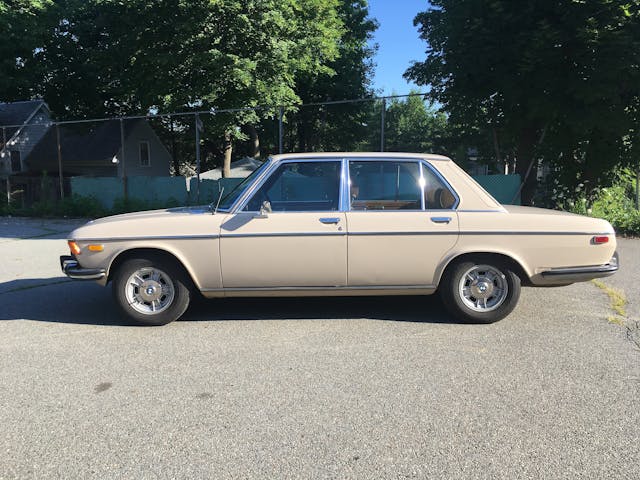
The first models rolled out in 1968, available in the United States in 1969, were the basic 2.5-liter 2500 and the option-laden 2.8-liter 2800, the latter of which even had a self-leveling Nivomat suspension so that its cavernous trunk could be packed to the gills and the car would pump itself horizontal. An automatic was available, but like the 2002 and E9 coupe, most of the cars were equipped with a four-speed stick, marking it as a driver’s car. Reviews were very positive, but the cars were expensive—a 2800 stickered at $6369, more than twice the cost of a ’69 2002—so sales lagged.
In 1971, U.S. importer Max Hoffman convinced BMW to bundle the options a different way and offer the 2.8-liter car with the more basic amenities package from the 2.5-liter car. In a curious bit of marketing, this newly packaged American-market E3 was named the “Bavaria,” intended to reinforce the car’s German-ness (as if the fact it was built by “Bavarian Motor Sport” wasn’t enough). To this day, the Bavaria remains the only BMW model ever to have a non-numeric name. The strategy appeared to work. With an initial list price that was a whisker under five grand, sales began increasing.

For the 1972 model year, displacement of the M30 engine was increased from 2.8 liters to 3.0 liters. This change occurred in the E9 coupe as well, which went from being the badged the 2800CS to the 3.0CS. The badge on the trunk lid of the Bavaria remained unchanged, but you’ll sometimes see the two variants referred to in parts catalogues as the 2800Bav and 3.0Bav.
The option package on the Bavaria isn’t absolutely uniform. Nearly all of them have vinyl seats, no sunroof, air conditioning (remember, it’s an American-market package), and hand-cranked windows, but there are exceptions. My Bavaria, for example, has power windows.
In 1973, it gets confusing. BMW brought back a fully loaded E3 and badged it as the 3.0S. So you had dealers selling two E3 sedans—the Bavaria and the 3.0S—with completely different names and differing only in things like leather, sunroof, self-leveling suspension, and a tool kit, while also selling two completely different models—the E3 3.0S four-door sedan and the E9 3.0CS two-door coupe—that differed only by one letter. Like I said, confusing.
In 1974, all BMWs, like every other car sold in the U.S., had to pass tougher DOT crash standards, and thus the ’74 Bavaria was fitted with 5-mph “diving-board” bumpers. As with most 1974 models, these bumpers were a hastily bolted-on affair, as opposed to something designed into the car’s aesthetic.
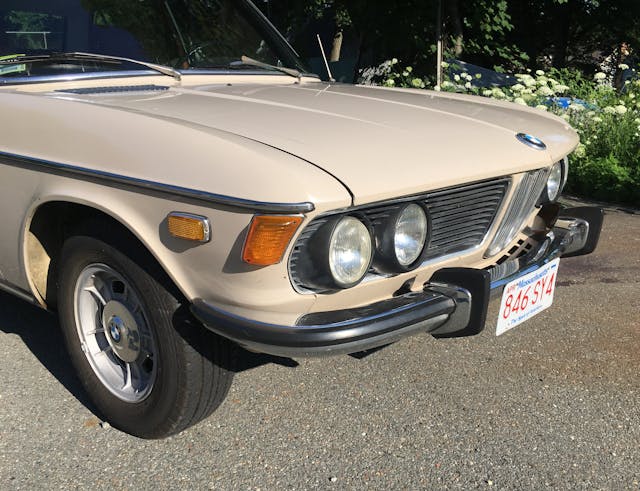
In 1975, BMW returned to numeric badging and the “Bavaria” name was dropped. In order to comply with new EPA standards, the dual Zenith carburetors were replaced with Bosch L-Jetronic fuel injection. Thus the 3.0S became the 3.0Si. This added to the confusion that continues to this day. Anyone pounding the internet searching for a 3.0CS or a European 3.0CSi E9 coupe who stumbles on an ad for a well-priced 3.0S or a 3.0Si has 10 seconds of heart palpations before they look at the photos and verify that the car is an E3 sedan and not the order-of-magnitude-more-valuable E9 coupe.
The 1975 model year also brought the E12 5 Series sedan. Introduced in Germany in ’72, it came to the United States as the 530i, so for the next two years, the E3 and the E12 (the “Bavaria” and the 530i) were sold at the same time. This confuses many people who think that the 5 Series was the replacement for the Bavaria. It wasn’t. The E23 7 Series, which debuted in the U.S. in 1977, was the replacement for the Bavaria.
Just to complete the discussion of nomenclature, in the United States, most BMW folks pretty much accept “Bavaria” as an umbrella term for “2500–2800-Bavaria-3.0S-3.0Si.” “E3” is more accurate, but the non-BMW-person doesn’t know what that is. If you own, say, a 2800, 3.0S, or 3.0Si, and mention its model name, unless you’re standing right next to the car and pointing to it, people are likely to think you’re talking about an E9 coupe. It’s just easier to say “Bavaria” for all the variants.
So, that’s what they are and what they’re called. Now what’s so cool about them?
Well, first, the interior of any car is about the real estate, how you feel entering the living room and plunking down on the couch, and just about any 1970s German car has a very satisfying feel as compared to an invasion-of-the-bean counters ’70s American car. From the pleated vinyl to the laughably large bus-size steering wheel to the functional instrument cluster design intended to keep you alert, aware, and informed as you have the accelerator pinned at 120 mph for hours on the autobahn, the interior of the Bavaria is a cool place to spend time. I love the wood dashboard in my 1973 3.0CSi, but the wood veneer is fussy and cracks easily with exposure to sun. Also, it simply looks older; it has its origins in the wood dashboard from the four-cylinder 2000CS. In contrast, the dashboard in the E3 has a small elegant 1-inch-wide wood accent piece and a modern-looking set of blackface gauges that would look completely at home in any BMW from 1968–92 (coincidentally, the same lifespan as the M30 engine).
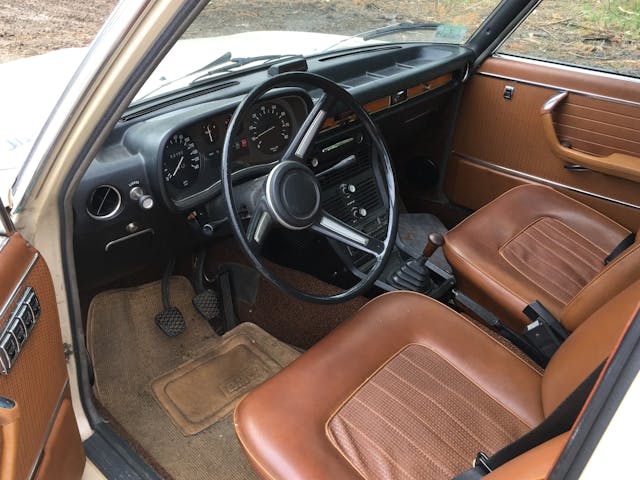
And the rest of the interior is incredibly functional. The back seat is huge, with lots of legroom, and the trunk can swallow two guitars, two kegs, two unconscious passengers … you get the idea.
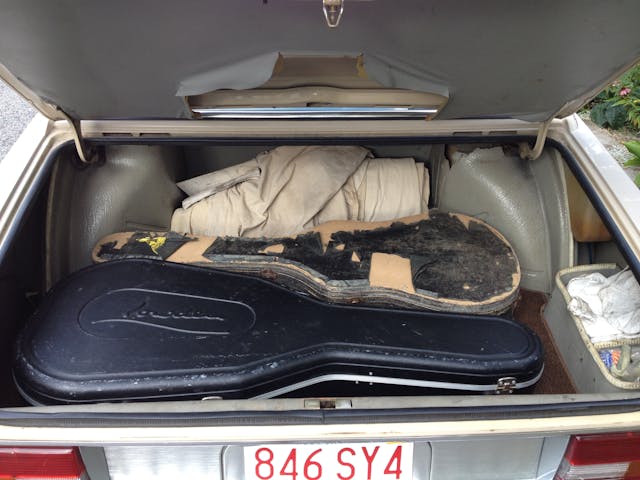
Exterior-wise, while there’s no pretending that the E3 gets the blood pumping the way its E9 coupe sister does, it’s a very clean, purposeful design. The E3’s nose is so similar to the E9 coupe that it takes the same grilles. Both cars look much trimmer in their small-bumper, pre-1974 configuration.
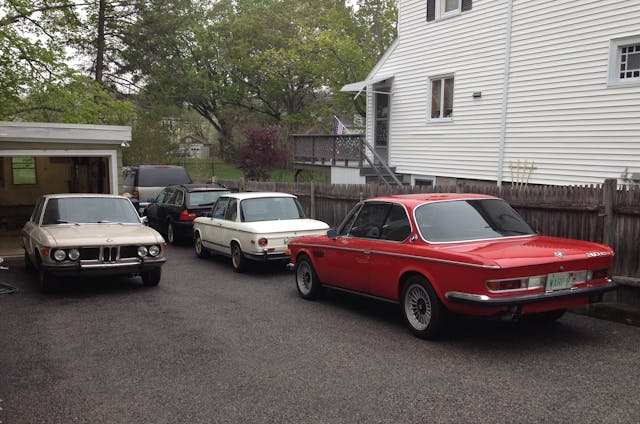
Performance-wise, the E3 is very similar to the E9 coupe. And that’s no surprise since they have the same drivetrain, the same front suspension, and a very similar rear suspension. Almost any well-cared-for E3 or E9 has had its original Zenith-Stromberg carbs replaced with a pair of Weber 32/36s. The horsepower—usually quoted as 168 for the 2800 and 178 for the 3.0—doesn’t sound like much by modern standards, but that horsepower and 200 ft-lb of torque are more than enough to be big fun. I love my little 2002s, but the grunt of the “big six” M30 is addictive, and the engine gives an authoritative Teutonic timing chain rasp when you nail it and open up the second barrel of the Webers without the sound being over-the-top snotty like an Italian car.
So, basically, in an environment where a nice E9 3.0CS is 60 grand, a decent Bavaria will get you a similar driving experience and ’70s German interior for probably one-fifth to one-tenth the cost.
That is, if you can find one. Although Bavarias don’t have the pre-rusted-at-the-factory Karmann-built bodies of their E9 siblings, or the front fenders whose removal requires cut-off with a torch, they are as rust-prone as any other old pre-galvanized car. And, unlike E9s, E3s weren’t treasured personal vehicles; they were bought as daily transportation, used, and thrown away.
I was lucky with mine. I’d owned a Bavaria in the 1990s, used it as a family daily driver for a few years, and remembered it fondly. I found my current one on Craigslist in 2013. It was advertised as rust-free with a $5000 asking price. I called the seller and said “Come on, no Bavaria is rust-free.” He explained that the car came from California, and the previous owner showed it at East coast events, but he passed away and the car was put in storage and had been sitting for years. He said that the car was now in his warehouse just across the Maine / New Hampshire line, was up on a lift where he was going through the brakes, and I could inspect it for rust myself.
After a friend of mine threatened to go see it if I wouldn’t, I drove up to Kittery, Maine, even though my job had become unstable and buying another car was a stretch. When I arrived at the warehouse, I found the owner on his cell phone. He pantomimed, “I have to take this call,” handed me a drop light, and motioned me to the Bavaria on the lift. I walked under the car and examined the floor, frame rails, and rocker panels. He was right; I could not find a single spot of rust-through anywhere on the car. All I saw were a few patches of the most minor surface rust.

When he got off the phone, he lowered the lift so I could examine the interior. It was in excellent condition—completely original, no splits in the vinyl seats, original intact rugs, perfect headliner, uncracked dash.
“Does it run?” I asked. He smiled, reached in, cracked the key, and the M30 fired up and idled smoothly, betraying a rotted muffler.
As we chatted, the seller said, “In truth, I know who you are. I’ve been reading your stuff for years. I’d love for the car to go to you. How about four grand?” I mumbled something about thinking I was about to lose my engineering job and not having garage space (both true).
He said, “I tell you what. Give me a hundred bucks and I’ll keep the car here in the warehouse for you until spring.”
How are you not supposed to take someone up on an offer like that? So I did.
When spring came, my work situation hadn’t improved. I pride myself on keeping my passions in balance with my family finances and thought that I should do the right thing and bail out of the car. But then I decided that, no, I should see it again first. Then, ever practical, I decided that I should drive up there with the Suburban and a rented U-Haul auto transporter, prepared to either buy it or bail, whichever my heart/head barometer directed me.
I arrived back in Kittery. By now the car was not only down off the lift with the brakes reassembled, but out in the warm spring sun. The seller said I could drive it but warned me that the power brakes weren’t working. I fired it up, sat in that beautiful German interior, drove it around the parking lot, and thought, “Yeah, I’m totally buying this car. You pass on something like this and The Automotive Powers That Be will never drop anything else interesting in your lap.” I drove to a nearby Bank of America, withdrew the cash, loaded the Bavaria onto the trailer, and towed it home.

An annual BMW event I attend, “The Vintage” in Asheville, North Carolina, was coming up in two weeks. Driving the Bavaria down there wasn’t even a remotely considered pipedream. Then, while investigating the Bavaria’s non-functional power steering, I found that the check valve between the booster and intake manifold had been inserted backwards. I reversed it, and voila. Then I fixed the rotted muffler by wrapping it in a piece of chimney flashing and holding it place with three big hose clamps, a repair that remains on the car to this day.
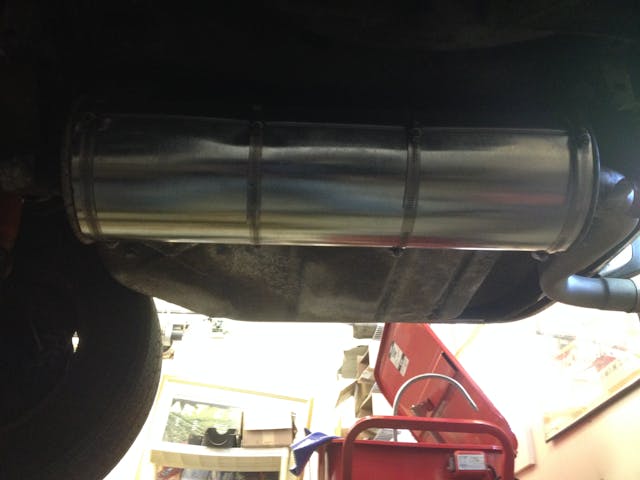
As I drove the car, I was astonished by how little it seemed to need. A car is an active participant in the sort-out process. Some go willingly, and others drag their feet at every step. This Bavaria clearly wanted to go to The Vintage. So I drove it. Its suspension, with what may have been the original shocks and struts, was very soft, with laughable levels of body lean, but it was quite comfortable.

I eventually updated the car’s suspension with a set of Bilstein HD shocks and fatter Suspension Techniques sway bars. This killed most of the floaty boaty feeling while keeping the comfortably sprung feel intact. I can now toss it into entrance ramps and not feel like I’m going to die, but if that was the car’s main use, I’d toss in stiffer springs and replace the 14-inch wheels and tires with something that has shorter, stiffer sidewalls. But the goal isn’t to try to turn it into a big 2002. It’s perfect the way it is.
Some cars you love because of their looks, some get you with raw acceleration, others their corner-carving capabilities. Some cars are great road-trip vehicles, and some are just cool to bring to events so others can gawk at them (even if you don’t want to admit that to yourself). The Bavaria is a little of all of these. Unlike my other vintage BMWs, I haven’t removed the big old horsehair-padded German seats and bus wheel and installed vintage Recaros and a Momo. The interior hangs together as a period-correct unified whole. It’ll comfortably cruise at 85 all day, and the 3.45 rear end is tall enough that the engine isn’t buzzy and doesn’t feel like it needs the legs of a five-speed like a 2002. If you want to toss it into entrance ramps, the big sedan says, “OK, let’s do this,” even if it means sliding out of the seats. Tan (well, Sahara) isn’t a love-it color for me, but it perfectly complements the tobacco interior, which I adore. Since the Bav wasn’t nearly as common as the 2002, it doesn’t elicit the same “Oh, my boyfriend had one of those in graduate school, and I loved that car!” comments from 70-year-old women that the 2002 does (true), or create drooling gawks like the E9. But those in the know will stop and stare.
All I need to complete it is a tweed sport coat with leather elbow patches and a 45-year-old parking sticker that discreetly identifies the car as belonging to, say, the head of the math department at Amherst College.
So, if you have vintage BMW lust and want an E9 coupe but don’t have $60,000 lying around, you might think about looking at an E3. Values are still surprisingly low. Nice, solid, driver-quality cars seem to cluster around six or seven grand, but they are few and far between. Check for rust in the floors, frame rails, rockers, and front and rear shock towers like you would any car. The M30’s long straight aluminum head is prone to warping and cracking if the car is overheated, so be certain to check for sweet-smelling exhaust and bubbles in the radiator.
And if, after buying it, you find a well-priced E9 coupe, well, you’ll have a spare set of front grilles.
***
Rob Siegel has been writing the column The Hack Mechanic™ for BMW CCA Roundel magazine for 34 years and is the author of six automotive books. His most recent book, Just Needs a Recharge: The Hack Mechanic™ Guide to Vintage Air Conditioning, is available on Amazon (as are his other books), or you can order personally-inscribed copies here. His new book, The Lotus Chronicles, will be released this fall.
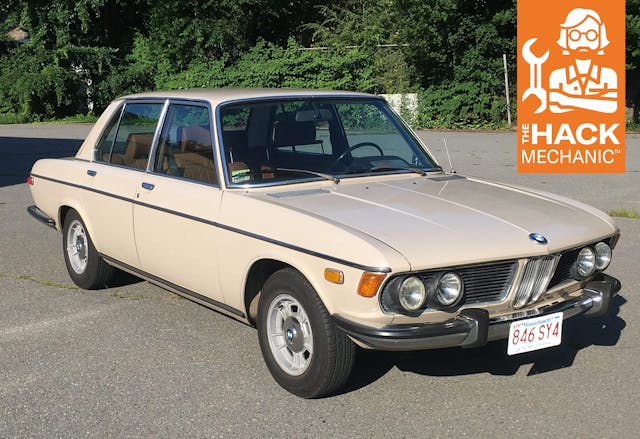












I currently have a BMW straight six dual carb dual exhaust with transmission what is it what’s it worth and is there anybody looking for one
Amazing article Rob! Thank you for helping to orient me. Seeing a Bavaria come up on local classifieds I had some questions and you answered them!
I loved my 1973 Bavaria! Baikal/black leatherette , manual, big brakes, front roll at
Springs/Bilstein shocks , zenith carbs( that worked. Great memories tearing around Colorado and Los Angeles. Until the Chief of Police of Santa Monica went through a red light and T-boned me.
i just started reading hagerty recently, and came across your writing. [sorry, my caps button on my MacBook is broken]. i enjoyed your earlier articles enough to keep going, but this one got to me. when my dad passed away too early, my mom was 55 and wanted to start afresh, all the six kids were through college. so she up and moved to la jolla ca and got herself a brand new metallic blue bavaria. she was not a car aficionado in any way, but wanted to make a statement. so she assigned me and my older brother jimmy – the black sheep – to deliver from chicago to san diego. my first epic road trip – i was 20. . adventures ensued, but that car – my god it loved cruising at 90 all day long. i thought the suspension was a bit too spongy, but everything else was extraordinary. .and i was a dyed-in-the-wool amercian car dude – pontiacs or death. . german – totally weird to own a german car. it was the manual and i loved the sound of the engine, even the starter motor sounded cool and exotic. and glass everywhere. i now drive [my summer car] a 98 323 convertible, and i will keep it forever. it’s been the most reliable car i’ve ever owned. and with the top down on a sunny day, the styling still holds up – i look like a rich arrogant asshole and they don’t realize their hyundai sonata is worth ten times more – they think it’s a recent auto. way of the world. this summer i installed a new bumper cover and new front fender. so next spring when i take her out of hibernation she will be the best she’s ever been. joy. and no i’m not modifying anything on it. i still can’t reckon idiots who lower them down to the ground – looks stupid. and the rest of them get converted into drift cars. a waste, but at least the car lives a few more years. but it is a truly timeless design, to be 25 years old and still look contemporary. as for the bavaria, my mom moved on to a jaguar xj6, not nearly as nice, but the old widowers in la jolla knew what it was and that was enough. i did get one great road trip adventure out of it so i will live on in my memory as – memorable. thanks for your writing efforts. good writing. i’ll check out your books. cheers, kevin o’callaghan [in minneapolis]
excellent tip re; wrapping the muffler in roofing material. i may use that on my leaky 99 range rover exhaust. cheap and do-it-yourself ethic. like [exclamation point].
I own a 1973 BMW Bavaria, how can I find out what engine size?
Loved the article on the e3. I have just finished restoration of mine. Same as yours with the same paint Sahara 006. Love the colour. It seems to never look dirty. I have however removed the original tan seats and put in mint black seats. I have your book and getting the a/c done in the spring.